LOUIE MARINCOVICH
SENIOR RESEARCH ASSOCIATE
DEPARTMENT OF INVERTEBRATE ZOOLOGY & GEOLOGY
My fascination with paleontology began at age 10 when I read the children's book "All About Dinosaurs." The famous paleontologist, Roy Chapman Andrews, recounted his expeditions to the Gobi Desert in the 1920s, when he made many new discoveries, including the first-ever dinosaur eggs. I became hooked on finding fossils in remote landscapes. I started collecting fossil sea shells around my boyhood home, town of San Pedro, California, not knowing then that San Pedro was a famous locale where a number of famous molluscan paleontologists had worked. Much later, as a college student, I took summer jobs in Alaska and became enthralled by the ethereal landscapes of the Arctic as a place to do research. So, in a roundabout way, I finally came to study fossils in remote place -- marine mollusks in the Arctic instead of dinosaurs in the Gobi Desert.
My fieldwork and research in the Arctic focus on molluscan faunas of the Cenozoic Era, the last 65 million years of geological time. Most of my work involves Alaska, but I have also worked in the Canadian Arctic Islands as far north as latitude 81 North. The Arctic is the least well-known of the world's oceans, and the surrounding land is mostly a remote, uninhabited wilderness rich in wildlife. Working in Arctic frequently requires living in isolated tent camps up to 300 miles away from any supply base, so doing research there happily leads not only to novel scientific discoveries but to adventures as well. My fieldwork and research are divided between two geographic areas, the Arctic Ocean and the high-latitude North Pacific Ocean.
Much of my work on the Arctic Ocean is aimed at learning the history of the marine "gateways" that connect it to the North Atlantic the North Pacific. When these marine gateways are open, as they are today, marine animals can migrate freely between the Arctic, Pacific and Atlantic oceans. When these gateways are closed, as they have been for most of geological time, it is because North America has become joined to Asia and/or Europe by land bridges that cut off migrations of marine organisms, but allow land animals to migrate between continents. The history of these gateway openings and closings is recorded by the molluscan faunas I study and by the terrestrial vertebrate and plant biotas that my colleagues study. Most recently, my research team of American and Russian paleontologists has documented that Bering Strait first opened between 4.8 and 5.5 million years ago. We have built on this discovery to show that the flow of sea water through Bering Strait actually reversed its direction of flow from southward to it present-day northward direction about 3.6 million years ago, and that this change was directly caused by tectonic formation of the Isthmus of Panama. This is the first correlation of paleogeographic and paleoceanographic events between the Arctic and the tropics, and it has important implications for global climate. Scientists who study climate history have used our age for Bering Strait's opening, and our age for the flow reversal through the strait, to fine-tune their supercomputer models of Northern Hemisphere climatic and oceanographic history. Understanding the history of arctic gateways involves studies of the taxonomy, paleobiogeography, paleoecology, and biostratigraphy of marine mollusks, and integrating my work with that of many colleagues.
My work in the high-latitude North Pacific is mainly focused on learning the sequence of molluscan faunas that developed in response to climatic, tectonic and oceanographic changes during the Cenozoic. This has involved frequent field excursions to southern Alaska, ranging from the rain forests of southeastern Alaska, to the stark mountains and glaciers of the central Gulf of Alaska, to the mountain tundra of southwestern Alaska (the Alaska Peninsula). This molluscan faunas of this region are a paleontological Rosetta Stone, because they are made up of species that evolved in Asia and sometimes migrated to Alaska, species that evolved in the U.S. West Coast and occasionally migrated north, and species endemic to southern Alaska. By studying these diverse Alaskan faunas, my colleagues and I are integrating the paleontological histories of the northwestern and northeastern Pacific to form a comprehensive picture of how North Pacific Cenozoic mollusks responded to changes in climate, tectonics and paleogeography.
SOME PUBLICATIONS
Marincovich, L., Jr., 2000, Central American paleogeography controlled Pliocene Arctic Ocean molluscan migrations: Geology, v. 38, no. 6, p. 151-154.
Marincovich, L., Jr., and Gladenkov, A. Y., 1999, Evidence for an early opening of the Bering Strait: Nature, p. v. 397, p. 149-151.
Marincovich, L., Jr., 1996, Survivorship of Mesozoic mollusks in the Paleocene Arctic Ocean, in N. MacLeod and G. Keller, editors, The Cretaceous-Tertiary mass extinction: biotic and environmental changes. New York, W. Norton and Co., p. 275-288.
Bice, K. L., Arthur, M. A., and Marincovich, L., Jr., 1996, Late Paleocene Arctic Ocean shallow-marine temperatures from mollusc stable isotopes: Paleoceanography, v. 11, no. 3, p. 241-249.
Marincovich, L., Jr., 1993, Danian mollusks from the Prince Creek Formation, northern Alaska, and implications for Arctic Ocean paleogeography: Paleontological Society Memoir 35, 35 p.
Marincovich, L., Jr., Brouwers, E. M., Hopkins, D. M., and McKenna, M. C., 1990, Late Mesozoic and Cenozoic paleogeographic and paleoclimatic history of the Arctic Ocean Basin, based on shallow-water faunas and terrestrial vertebrates:Geological Society of America, The Geology of North America, v. L, The Arctic Ocean Region, p. 403-426.
Marincovich, L., Jr., 1988, Late middle Eocene mollusks of the Tolstoi Formation, Alaska Peninsula, and correlations with faunas from California to the Far-eastern U.S.S.R., in M. V. Filewicz and R. L. Squires, editors, Paleogene stratigraphy, West Coast of North America: Pacific Section, Society of Economic Paleontologists and Mineralogists, West Coast Paleogene Symposium, p. 265-281.
Marincovich, L., Jr., 1988, Miocene mollusks from the lower part of the Bear Lake Formation on Ukolnoi Island, Alaska Peninsula, Alaska: Natural History Museum of Los Angeles County, Contributions in Science, no. 397, 20 p.
Kotaka, T., and Marincovich, L., Jr., 1986, editors, Japanese Cenozoic molluscs--their origin and migration: Palaeontological Society of Japan, Special Papers, no. 29, 255 p.
Marincovich, L., Jr., 1983, Molluscan paleontology, paleoecology, and North Pacific correlations of the Miocene Tachilni Formation, Alaska Peninsula, Alaska: Bulletins of American Paleontology, v. 84, no. 317, p. 59-155, pls. 12-23.
http://www.loumarincovich.com/
CAPTIONS FOR GRAPHICS
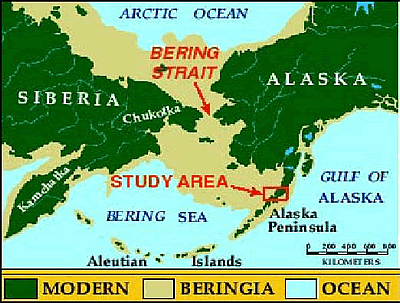
Figure 1: My research team documented the age of Bering Strait's earliest opening by doing paleontological field work on the Alaska Peninsula of southwestern Alaska. Our field area is shown by the red rectangle. The Bering Strait first opened between 4.8 and 5.5 million years ago.
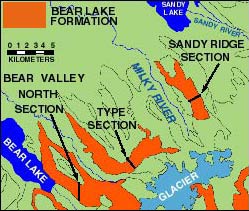
Figure 2: A closer look at our study site, in the vicinity of Bear Lake. We investigated the rocks shown in orange. Our main study site was Sandy Ridge, in the upper right. There are no roads in this area, so we worked by helicopter.
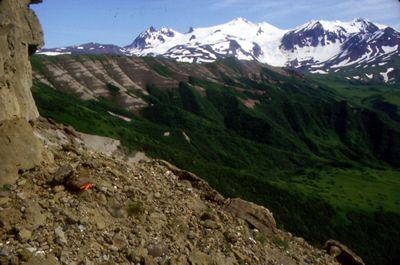
Figure 3: This is one view of our study site, Sandy Ridge. This view to the east shows part of Sandy Ridge extending from my red backpack toward the volcanic spine of the Alaska Peninsula.

Figure 4: Looking west, this shows the complete Sandy Ridge stratigraphic section. The bottom of the stratigraphic section is a dark-colored basal conglomerate, below which are older nonmarine rocks with black coal beds that delineate spectacular folds in the rocks. Our blue and white helicopteris sitting just above the basal conglomerate.
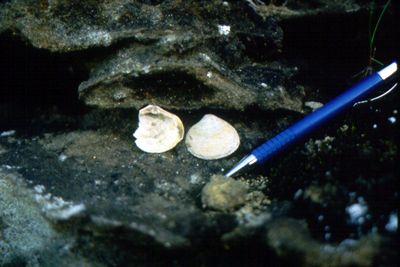
Figure 5: This is the mollusk, Astarte, which we were searching for at Sandy Ridge. This bivalve lived in the Arctic Ocean until Bering Strait opened and allowed it to migrate into the North Pacific. If we found Astarte here, we would know that the strait had opened.
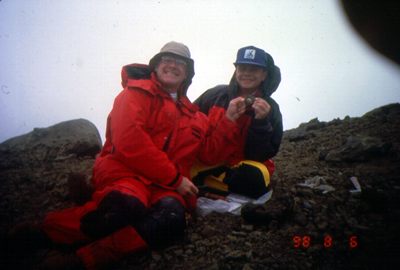
Figure 6: Eureka! Louie Marincovich (left) and Konstantin Barinov, (right) with the first specimen of Astarte found at Sandy Ridge. Dr. Barinov is a colleague from the Russian Academy of Sciences, Geological Institute, Moscow.
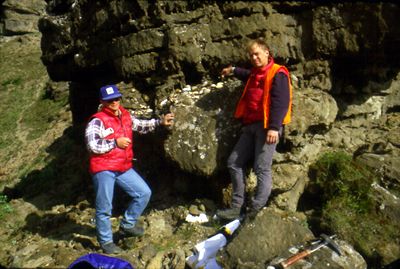
Figure 7: Colleagues Konstantin Barinov, Russian Academy of Sciences (left) and Anton Oleinik of Florida Atlantic University (right) at a Sandy Ridge bed with abundant mollusk fossils. The fossils appear as white objects in the rock layers and lying upon a ledge between the two men.

Figure 8: We determined the age when Astarte migrated through Bering Strait by analyzing diatoms from within the shells of Astarte and other mollusks from Sandy Ridge. The diatoms represent Neodenticula kamtschatica Subzone B, shown by the red rectangle and thick red vertical bar. This diatom subzone has an age range of 4.8 to 5.5 million years ago, so this is the age range during which Bering Strait first opened. Individual diatom species with age significance are shown by the colored vertical bars. We are continuing our work to refine this age range.